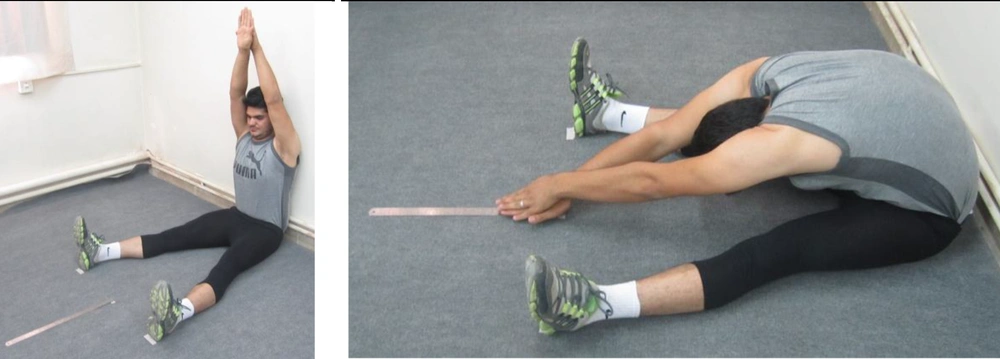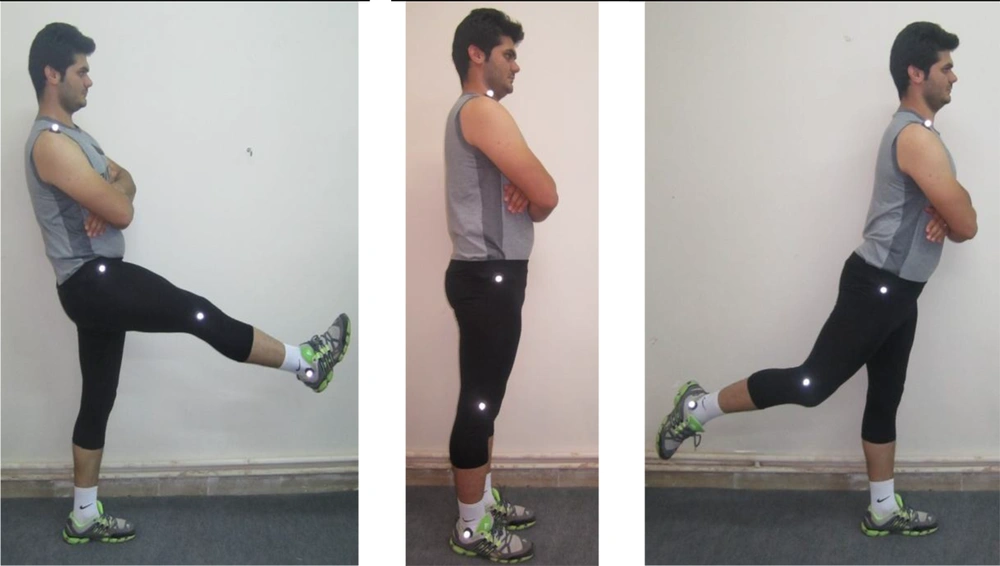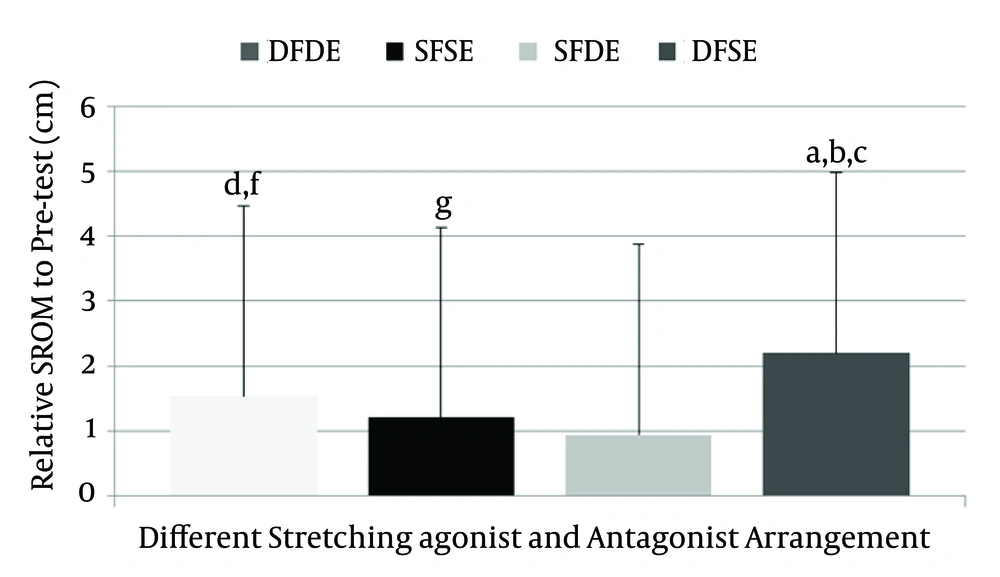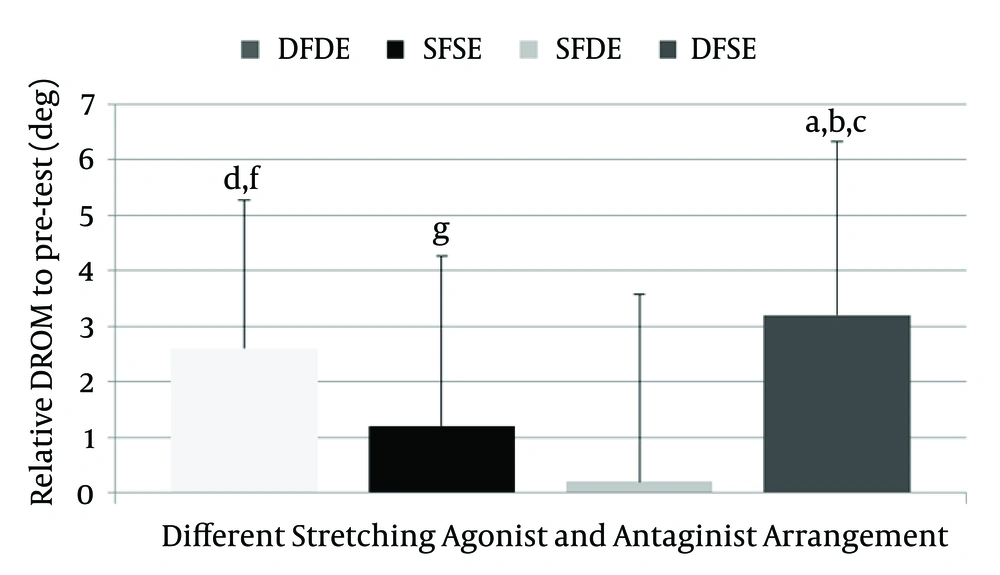1. Background
Traditionally, stretching exercises are considered as basic components of warm up aiming to prepare the musculoskeletal system for performance and to prevent injuries. However, research findings on the acute effects of stretching are rather conflicting as there is no single type or program of stretching exercises that can improve dynamic sport performance (1, 2).
Research studies have shown that static stretching decreases force production due to muscle stiffness reduction and an alteration in the force-velocity relationship (3-6). Previous research studies reported that static stretching performed during the traditional warm-up impairs performance as reflected in a decline in power, acceleration, range of motion (ROM), speed and agility (7-10). In contrast, dynamic stretching exercises have positive effects on muscular performance and this has been attributed to a higher post activation potentiation (PAP) (11-16).
Most research studies have examined the acute effects of various stretching methods on performance by measuring the joint ROM statically prior to and immediately after stretching (17-21). Improvement in static joint ROM cannot guarantee that a particular stretching program can improve sports performance, unless alterations in joint range of motion and muscular activity are measured during dynamic performance. Evidence suggests that dynamic stretching exercises result in a greater dynamic range of motion (DROM) during kicking compared to static stretching exercises of the hip muscles (1). To our knowledge, improvements in static ROM (SROM) (i.e. ROM measurement in a static position of the target joint) versus DROM (i.e. The ROM is measured during dynamic motion of the target joint) after stretching have not been previously investigated. Such information may assist in determining the applications and limitations of various stretching techniques and programs.
The majority of previous studies has compared static vs. dynamic stretching by using the same type of stretching for all muscles around a joint or for multiple muscles around various joints (1, 2, 4, 7, 8, 12, 13). However, dynamic sport performance does not require the same level of strength, stiffness and range of motion from all muscles around a joint. For example, it is reasonable to suggest that for a given joint motion, agonist muscles may be required to exert higher levels of force and stiffness while antagonist muscles simultaneously can allow faster joint movement through a higher stretch (and less stiffness) and less force production. To our knowledge, only one study, that by Sandberg et al. (22) has found that static stretching of the antagonist muscles, improved jumping height performance, possibly due to improvements in agonist muscle utilization during jumping. If static stretching decreases muscle force production and stiffness while dynamic stretching increases force production and stiffness, it seems that there must be a combination of types of stretching for agonist and antagonist muscles that leads to better increases in dynamic sport performance.
2. Objectives
The purpose was to investigate the effects of different agonist and antagonist stretching arrangements of hip flexors and extensors on hip SROM and DROM in trained male subjects. The main question was: which stretching arrangement for agonist and antagonist hip muscles causes greater SROM and DROM in the hip joint?
3. Materials and Methods
3.1. Subjects
Sixty trained males (mean ± SD: height, 177.38 ± 6.92 cm; body mass, 68.4 ± 10.22 kg; age, 21.52 ± 1.17 years), who had no history of major lower limb injury or disease, volunteered to participate in this study, after providing their informed consent. Subjects who were randomly selected, engaged in a physical fitness training program of a minimum of three times a week, for the past six months in Kerman city. Ethical approval for this study was obtained from the University Committee. Subjects were required to report to our research laboratory and complete a medical questionnaire and declare their consent.
3.2. Procedure
A within-subjects and pre and post-test experimental design was applied. The protocol included performances of four acute stretch interventions, each representing a different combination of static and dynamic stretches of the hip flexors (agonists) and extensors (antagonists). The acute stretch interventions differed only in the mode of stretching method used, whereas all other exercises used in the warm-up were identical. The protocols were: (i) static stretching for both hip flexor and extensor muscles (SFSE), (ii) dynamic stretching for both hip flexor and extensor muscles (DFDE), (iii) static stretching for the hip flexors and dynamic stretching for hip extensors (SFDE), and (iv) dynamic stretching for the hip flexors and static stretching for hip extensors (DFSE). To achieve this, the participants visited the laboratory on four occasions, separated by at least 72 hours. SROM and DROM (dependent variables) were captured before and immediately after each warm-up protocol. Each testing session included jogging for 4 minutes, assessment of SROM and DROM (pre-test), the performance of the main stretching program, 2 minutes rest and eventually SROM and DROM tests as a post-test.
3.3. Static Stretching
The participants performed static stretches of the hip flexors and extensors. They were instructed to stretch in a slow, deliberate manner with proper body alignment and hold the stretch for 15 seconds. Hip extensor muscle stretches were performed from the supine position with both legs extended. The subjects then flexed the right knee leg toward their chest by holding it with both hands and then pulling it toward their chest. The left leg remained extended throughout the stretch. Hip flexor muscle stretches were performed from a kneeling position, with one knee up and another knee on the ground. The trunk was maintained straight and the hands were placed on the front knee (1, 2). The participant stretched the muscles of the hip by shifting his body mass towards the front knee and “pushing” both hips downwards.
3.4. Dynamic Stretching
Dynamic stretching of the same muscle groups as the static stretching protocol were adopted from studies by Amiri-Khorasani et al. (1, 2). Subjects were instructed to attempt maximal ROM during each repetition. Each subject intentionally contracted the antagonist of the target muscle in a standing position once every second so that the target muscle was stretched. This stretching was performed five times without any bouncing at three different speeds, which were prescribed in the order of slow, moderate, and ‘as-fast-as-possible’. The order of target muscles and the rest periods were the same as those in the static stretching. For hip extensors, subjects contracted hip flexors intentionally with the knee flexed to bring the thigh to the chest. On the other hand, for hip flexors, from a comfortable standing position, the subject contracted the hip extensors to swing the leg backwards.
3.5. Range of Motion Assessments
A V-sit flexibility test was conducted to measure SROM of the hip joint (Figure 1) (19). Subjects sat on the floor with a measuring line between their legs with the soles of their feet (without shoes) placed exactly behind the baseline. The thumbs were clasped so that hands were together, palms facing down, and placed on measuring line. With the legs held flat by a partner, subjects slowly reached forward as far as possible, keeping the fingers on the baseline and feet flexed. The highest score was selected and stored for further analysis.
To measure DROM, as illustrated in Figure 2, subjects stood upright (hip angle = 0°) and their hands were placed on their iliac crests. Their trunk and left leg were fixed by tape to a wall to prevent their motion during stretching. From this position, the participants were instructed to actively swing their right leg forward (hip flexion) with an extended knee as much as possible. Five trials were performed. Kinematics data were collected using a 3-camera, 3-dimensional motion analysis system (Eagle; Motion Analysis Corp., Santa Rosa, CA, USA) at a sampling frequency of 200 Hz. Once the cameras were positioned in the appropriate location (performance area), they were calibrated to define their own volume origin. Reflective markers were placed at selected anatomical landmark positions, namely on the right shoulder, lateral greater trochanter, epicondyle of the knee, and lateral malleolus. Following data capture, coordinate data from bony anatomical landmarks were digitized in Cortex software (Motion Analysis Corp., Santa Rosa, CA, USA). Kinematic data were filtered using a fourth-order zero-lag Butterworth 12-Hz low-pass filter automatically. All trials were digitized and the maximum hip joint angular displacement was considered as DROM performance and stored for final analysis.
Finally, all post-test data variables from the different stretching arrangements were normalized to pre-test data. Therefore, post-test relative variables were calculated as (i) relative SFSE, (ii) relative DFDE, (iii) relative SFDE, and (iv) relative DFSE to pre-test data for all subjects. Furthermore, the reliability of the test protocol was determined in a pilot study. Particularly, subjects were tested twice on separate days, a week apart. Subsequently the intra-class correlation coefficients were determined for each dependent measure.
3.6. Statistical Analysis
A one-way analysis of variance was used to compare relative changes in each dependent variable between SFSE, DFDE, SFDE, and DFSE. The level of significance was P ≤ 0.05. When justified, paired sample t-tests were performed to confirm significant changes between pairs of means. The power was ≥ 0.94 and test-retest reliability values for the testing order of test ICCRs (intraclass correlation reliability) were ≥ 0.97 and ≥ 0.96 for the V-sit and DROM, respectively.
4. Results
All raw data are presented as pre-test and post-test values in Table 1. Relative changes in SROM after each protocol are presented in Figure 3. The analysis of variance indicated a statistically significant difference in relative changes of SROM values between the four acute stretch interventions (P < 0.05). Paired sample t-tests showed that (i) the relative increase of SROM was significantly higher after after DFSE (2.2 ± 2.78 deg) compared with that observed after DFDE (1.53 ± 2.16 deg, P = 0.04), SFSE (1.2 ± 2.93 deg, P = 0.03), and SFDE (0.93 ± 4.11 deg, P = 0.01), (ii) The increase after DFDE was also significantly higher compared with that observed after the SFSE and SFDE protocols (P = 0.04 and P = 0.03, respectively), and (iii) the increase after SFSE was also significantly higher compared with the increase after the SFDE protocol (P = 0.04).
| Tests | Stretching | |||||||
|---|---|---|---|---|---|---|---|---|
| SFSE | DFDE | SFDE | DFSE | |||||
| Pre | Post | Pre | Post | Pre | Post | Pre | Post | |
| SROM, cm | 3.66 ± 12.73 | 5.20 ± 13.56 | 1.33 ± 13.75 | 2.53 ± 14.31 | 4.93 ± 9.96 | 5.86 ± 10.24 | 10 ± 7.54 | 12.2 ± 8.12 |
| DROM, deg | 63.4 ± 18.98 | 73.6 ± 16.09 | 64.8 ± 16.20 | 69 ± 23.09 | 56.2 ± 14.60 | 68.8 ± 13.70 | 74.6 ± 19.78 | 87.8 ± 20.25 |
Mean ± SD SROM and DROM Before and After Different Acute Stretching Agonist and Antagonist Protocolsa
Relative changes in DROM after each protocol are presented in Figure 4. The analysis of variance indicated a statistically significant difference in relative changes of DROM values between the four acute stretch interventions (P < 0.05). Paired sample t-test showed that (i) the increase after DFSE (3.2 ± 3.13 cm) was significantly higher than that observed after DFDE (2.6 ± 2.68 cm, P = 0.04), SFSE (1.2 ± 3.07 cm, P = 0.02), and SFDE (0.2 ± 3.37 cm, P = 0.001) protocols, (ii) The increase after DFDE was also significantly higher compared with that observed after the SFSE and SFDE protocols (P = 0.04 and P = 0.02, respectively) and (iii) the increase after SFSE was also significantly higher compared with the increase after the SFDE protocol (P = 0.03).
5. Discussion
The purpose of this study was to investigate the effects of different agonist and antagonist stretching arrangements of hip flexors and extensors on hip SROM and DROM in regularly trained individuals. The results showed a significantly higher increase in hip ROM after DFSE compared to the remainder of the stretching protocols. To our knowledge, examination of the acute effects of different types of stretching for agonist and antagonist muscles on joint flexibility have not been previously examined.
The present study showed that the combination of dynamic stretching of the hip flexors and static stretching of the hip extensors showed higher hip flexion SROM and DROM improvements compared with all other protocols (Figure 3) which confirms our initial hypothesis. Dynamic stretching of the hip flexors probably enhanced muscle force capacity, activation and increased stiffness probably due to a higher post-activation potentiation (PAP) (11-16). In contrast, static stretching of the hip extensors led to a decline in muscle force generation capacity and stiffness (1, 2, 7-10). Consequently, when both types of exercises were used within the same protocol, a greater hip flexion motion was achieved (Figure 3). This was even more evident when examining DROM, probably due to a higher acute effect of dynamic and static stretching on the agonist and antagonist muscle function, respectively. This explanation is also enforced by the observation that when the hip flexors were stretched statically and the hip extensors dynamically (SFDE) during the same warm-up routine, the acute improvements in hip flexion ROM were lower than all other protocols (Figure 3). The possible reasons for these observations are: (i) positive effect of dynamic stretching on agonist muscles by allowing a greater number of cross-bridges to form, resulting in an increase in force production, which causes a higher PAP and (ii) an effect of stretching on antagonist muscle by a declining muscle-tendon unit stiffness and formation of a less number of cross-bridges.
The present findings support the hypothesis made by Sandberg et al. (22) that static stretching of the antagonist musculature would improve performance first, by increasing the neural drive to the agonist muscle, second, by decreasing neural drive to the antagonist muscle; and third, by reducing antagonist muscle stiffness and opposing forces or a combination of these factors. In fact, Sandberg et al. (22) reported an increase in vertical jump performance after static stretching of the antagonist muscles. Our study extends these findings further as the positive acute effects of static stretching of antagonist muscles were combined with the acute effects of dynamic stretching of the agonist muscles. It appears, therefore, that improvements in SROM and DROM are more likely to be higher when the agonists are stretched dynamically and the antagonists statically as part of the warm-up.
The results of this study showed a higher increase in ROM after dynamic (DFDE) stretching compared with static (SFSE) stretching (Figure 3). This is in disagreement with Duncan and Woodfield (17) and Faigenbaum et al. (19) who used a similar methodology to the present one and reported no significant differences in SROM after static and dynamic stretching. This difference may be due to their subjects who were youth participants aged 10 to 11 years. Two factors might have contributed to the higher increase after dynamic stretching. First, it has been extensively suggested that the increase in DROM after dynamic stretching might be due to a higher PAP (3-6, 12). Second, during dynamic stretching of the hip muscles, the abdominal muscles might contract isometrically to stabilize the trunk as the lower extremity moves dynamically during stretching exercise. In this case, a higher abdominal contraction due to PAP after dynamic stretching can cause a greater score in the V-sit flexibility test compared to static stretching. In brief, these two reasons may explain the greater SROM and DROM after dynamic stretching for both agonist and antagonist muscles (DFDE protocol) against static stretching for both agonist and antagonist muscles (SFSE protocol). A limitation of the present study is that some of the SROM group differences showed high standard deviation values. An effect of this variability on the present findings is unlikely as the preliminary tests showed high reliability of all scores in the same sample size. Nevertheless, further research in this issue including a larger sample size is waranteed.
In summary, this study showed that a warm-up protocol combining dynamic stretching of the hip flexors and static stretching of the hip extensors showed a higher hip flexion SROM and DROM improvement than the rest combinations of dynamic and static stretching of the same muscles.
The acute effects of warm-up on sport performance greatly depend on the type of exercises used as a warm-up. The present results indicate that there is no single type of stretching (i.e. only dynamic or only static stretching) of all muscles that enhances performance. Instead, it appears that the use of stretching exercises that are specific to the demands and the role of each muscle for the final performance yields better results. In this particular study, a higher hip flexion SROM and DROM was observed after dynamic stretches of the agonists and static stretches of the antagonists which has implications for skills requiring greater hip flexion.



